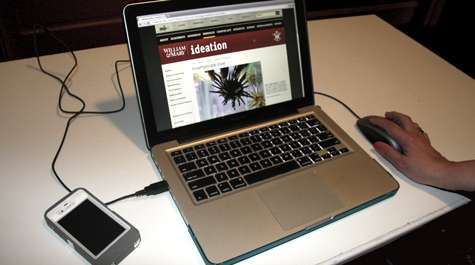Ph.D. students make advances in tethering & network security

The average American spends about seven hours a day looking at an electronic screen. With this much of a role in our daily lives, our electronic devices must be updated frequently with the newest technology to reflect usage patterns and make the user's experience more efficient and safe.
Two Ph.D. students in William & Mary's Department of Computer Science are doing just that. Hao Han and Nan Zheng recently received the Stephen K. Park Graduate Research Award to recognize their contributions to electronic efficiency and network security, respectively.
Han's research focuses on increasing battery life when a user "tethers" a smartphone to a laptop. Many laptop users tether" their smartphone and laptop, using the smartphone's data plan to access the internet.
"Tethering is very helpful because you can use it on many devices. In places without Wi-Fi this is very helpful," said Han. The problem, he said, is that tethering drains smartphone batteries. Han explained that in an area with no Wi-Fi there is likely to be no outlets to charge either device, leaving users in an unfortunate situation if they need either device for a long period of time.
Han, along with his mentors at Microsoft, are devising a strategy to put the smartphone into sleep mode to save precious battery time.
"Our goal is to have the phone go to sleep for a while so it doesn't run out of battery when you're not using it," said Han.
Wi-Fi coverage is expected to grow in the future, but Han believes tethering will still be useful because of the limitations of coverage. Han's research can also be adapted to conserve battery life on other devices. He says his research is valuable in today's world because of the number of people it affects.
"Every phone has a battery, and everyone is concerned about battery life. Solving this problem would help millions of smartphone users," said Han.
Zheng's research also has the potential to impact millions. Like Han's work with tethering, her research in network security could affect everyone that uses the world wide web.
"The web is now part of everyone's life. It's a critical problem if a malicious person wants to impersonate someone and post some comments online," said Zheng.
Zheng is aiming to make the web more secure by using mouse dynamics as an aid in user authentication. Zheng says that mouse movements as distinctive as handwriting.
"Each person has a unique way that they write," said Zheng. "Similarly, the curves people make and the dynamics of mouse movements are different from person to person."
Zheng explained that even though we have alternate methods of authenticating a person such as fingerprint or voice recognition, most people use passwords, which can be guessed or generated easily. By using an individual's mouse motions, a computer armed with mouse-recognition software can validate the user in as little as one swipe. Further, the software tracks mouse movements continuously. Zheng says continuous tracking means continuous user verification.
She points out that the current standard, password protection, offers protection only at a one-time log in—an unauthorized user who gets through that stage has complete access without having to go through another security check. Using mouse tracking as a backup to password protection means that a hacker who gets through one security check could still be shut down.
"If an attacker hacks into your account but they don't have the right password, this software can look at their mouse movements. From there we can determine it is not the correct person," said Zheng
Both Han and Zheng say their research can be applied to future technological advances.
"As long as we use batteries in handheld devices, we will always want to save battery life," said Han.
Recent inventions such as countertops that turn into stoves with a mere touch could benefit built in safety features using Zheng's research to preventing children from accidentally turning on the stove. By looking for certain finger movements, this device could be made to only turn on with a certain person's touch.
"When everything goes to touchscreen, mouse dynamics is something that could be adapted to new technology," said Zheng.
More information: dl.acm.org/citation.cfm?id=2307675
Provided by The College of William & Mary



















